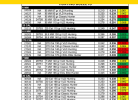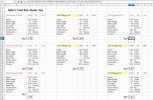Regardless of range, while it is NOT the only factor, "I" like my BC to be as high as possible.
Last edited:
 Help Support Long Range Hunting Forum
Help Support Long Range Hunting Forum
I thought the videos addressed what you noted exceptionally well.Like BCs themselves, this question could have a lot of answers. You don't really need to know BC to make good hits at distance. this is accomplished with practice. In fact you need to actually shoot at distance to verify BC. Estimated BCs make initial calculations much easier to predict drop and wind deflection to then actually achieve an accurate definition of a true BC in a given load/rifle. Once achieved, this will also define effective range to a bullets operating window for on target functionality. Do you nee to know the BC of a given bullet to make hits? No. Can it be a very good tool to aid in making hits? Certainly. A great, simple complicated question Sir!

100% correct, for BC alone to be a valid point of comparison between two bullets they must share a common design philosophy. Otherwise significant additional information has to be provided to be able to construct a comparison. The G7 form factor provides a decently condensed data point to account for design differences - primarily it accounts for bullet length as part of overall weight, and narrows the range of potential gyroscopic stability variances because similarly designed bullets will have similar velocity ranges where instability will cause a degradation of BC.So why is it so important to have an awareness and understanding of form factor? Isn't this what BC's are for; to be able to make comparisons between bullets using a single number? It's true that BC is a useful measure of merit for ballistic performance, but there's a problem with using BC's alone to assess ballistic performance. The problem with BC's is that they combine the effects of mass and drag into one number. So if a bullet has a high BC, you don't know if it's a medium weight bullet with very low drag, or a heavy bullet with high drag. The reason this is important is because if a bullet has a high BC just because it's heavy, it will suffer from having a depressed muzzle velocity, and performance will not be as good as the high BC implies.
LBC is simply part of the puzzle to creating a round to do exactly what you need it to do. Yes, it should be used to compare similarly designed bullets.
Sectional density is another value that needs to be compared to similarly constructed bullets and not just by itself, particularly in regards to penetration potential of the bullet. It depends greatly on how the bullet is constructed. I high amount alone does not necessarily equate to a high amount of penetration, and a low number does not necessarily equate to a more shallow penetration.
Regardless of range, while it is NOT the only factor, "I" like my BC to be as high as possible.
